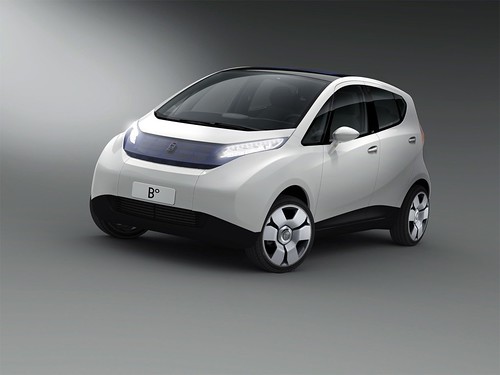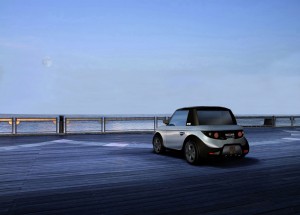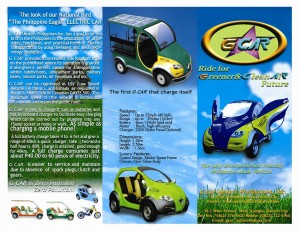A little over a month ago I wrote about Shai Agassi and his Better Place plan. And wow, does he work fast. Better place has added Oregon, Monaco, Australia, and California to its list of areas willing to build an Renault-Nissan electric vehicle charging infrastructure. This will include widely deployed charging spots, but will be centered around battery exchange stations, that will only take minutes to mechanically replace an electric car battery.
So much has happened in this past month for Better Place, I think it would be easier to give a bullet point rundown of the major events.
In a possibly related note, Mitsubishi announced it will be partnering with Oregon and California to bring electric cars to those states, most notably the Mitsubishi iMiev. However, no announcement has been made on how or if this has anything to do with Better Place’s plan to build battery changing stations in those states. If the iMiev’s batteries can be changed at the stations like the Renault-Nissans, this would be beneficial to both parties. Here is the homepage for Better Place, its got a lot of neat stuff, including its own Better Place social network. I’ll have to join.
Better Place’s Latest Press Release:
Press Releases
Thursday, 20 Nov 2008
21st Century Initiative in California Defines Roadmap for Sustainable Transportation, Green Job Growth and Opportunity to Reinvigorate Region’s Competitive Advantage
Better Place Announces Support of California Governor’s and SF Bay Area Mayors’ Commitments to Build Sustainable Transportation Infrastructure
San Francisco, Calif. (Nov 20, 2008) — At a press conference held in San Francisco City Hall, Governor Arnold Schwarzenegger, along with the Mayors of San Francisco, San Jose and Oakland, joined together with the Bay Area Council, the Silicon Valley Leadership Group, and Better Place of Palo Alto to announce a sweeping plan to reinvigorate the state and region’s competitive advantage in innovative technology through public-private investments in electric vehicles and other elements of “green” infrastructure. This new approach challenges conventional assumptions that economic and environmental recovery are at odds with each other, and aligns them, instead.
The group defined a vision for encouraging investment in green infrastructure as a means for boosting the state’s competitive advantage while reducing its dependence on oil for transportation and reducing greenhouse gas emissions. The group believes that the move to a sustainable mobility model of electric vehicles fueled by renewable energy, beginning in the Bay area, will serve as an economic and environmental stimulus blueprint for the entire country, particularly the nation’s lagging automotive sector.
“California is already a world leader in fighting global warming and promoting renewable energy,” said Governor Schwarzenegger. “This type of public-private partnership is exactly what I envisioned when we created the first ever low carbon fuel standard and when the state enacted the zero emissions vehicle program. This partnership is proof that by working together, we can achieve our goals of creating a healthier planet while boosting our economy at the same time.”
“Creating an energy-independent economy is our generation’s moon-shot,” said Robert F. Kennedy, Jr., Venture Partner and Senior Advisor, VantagePoint Venture Partners. “For too long we’ve believed that economy and environment stood at odds with each other. By coming together in this time of turmoil to build a clean transportation infrastructure, this generation will fuel the economic and environmental prosperity of generations to come.”
“Transportation accounts for about 40% of California’s greenhouse gas emissions, and is globally forecast to consume over half of all oil in the coming decades,” said Dan Kammen, Director, Transportation Sustainability Research Center, University of California, Berkeley. “This kind of public-private partnership is exactly what we need to create new jobs building a clean energy infrastructure, and contribute to economic and environmental recovery locally and globally. This initiative will help to put the Bay Area in the forefront of developing the science, engineering, and public policy innovations that simultaneously reduce greenhouse gas emissions and lead us to the next economic boom – the clean energy century. With the approach of the COP15 climate summit next year, this initiative can have truly global impact.”
The Bay Area will serve as the first region of California to make the switch from carbon-based transportation to sustainable mobility.
At today’s ceremony, San Francisco Mayor Gavin Newsom, San Jose Mayor Chuck Reed and Oakland Mayor Ron Dellums announced a series of policy initiatives for transforming the Bay Area into the “EV Capital of the US.” Mayors Newsom, Reed and Dellums jointly announced today that they would begin in December to work with the region’s cities, municipalities, regional governmental organizations and private sector partners to help shape the region’s economic and environmental future around sustainable mobility. (See separate release, “Bay Area Mayors Announce Partnership to Make Region the Electric Vehicle Capital of the US” issued by the Offices of Mayor Newsom, Mayor Dellums and Mayor Reed for more information.)
In conjunction with the news, Better Place, the world’s leading sustainability mobility operator, announced that it would enter the US market with California as its first state, beginning in the Bay Area. Better Place will work a similar infrastructure investment model as it has in Israel, Denmark and Australia. Network planning and permitting will begin in January 2009 with infrastructure deployment beginning in 2010.
Mass market availability of electric cars is targeted for 2012, and Better Place estimates the network investment in the Bay Area will total $1 billion when the system is fully deployed. The Better Place model is an open network model built on industry standards, allowing for fixed battery and battery exchange electric vehicles to operate on the network.
“At Better Place, we believe that the systemic issues facing our country today – climate change, economic downturn and the ongoing geopolitical struggle between energy rich and energy poor nations – all tie back to our addiction to oil,” said Shai Agassi, Founder and CEO, Better Place. “We believe the successful solution includes a confluence of leadership involving California’s strength in technology and innovation coupled with Michigan’s automotive manufacturing might, with the right policy and national project leadership from Washington. We are grateful for the support from Governor Schwarzenegger, whose policies have enabled this ‘blue ocean’ opportunity. If we tackle these issues through an integrated approach among cities, states and nations, the world wins.”
Also today, the region’s two largest associations – the Bay Area Council and Silicon Valley Leadership Group – announced their commitment to accelerating the change from a carbon-based economy to a low carbon economy. Both groups committed to working with their memberships to accelerate action on climate change and view the move to sustainable transportation as a critical first step.
“The green technology industry is going to boom, and it is our job is to ensure it booms here, in the Bay Area and California,” said Jim Wunderman, President and Chief Executive Officer, Bay Area Council. “We have the venture capital, we have the research universities, we have management talent, and, perhaps most importantly, we have the visionary elected leaders gathered here today to clear the field for green tech companies, like Better Place, with progressive public policy.”
“As one of the region’s leading business associations, the Silicon Valley Leadership Group is strongly committed to accelerating action on climate change and we view the move to sustainable transportation as a critical step forward for the region. As part of our commitment, the Leadership Group will continue to help accelerate commercialization of EV technology and leading-edge member companies such as Akeena Solar will continue to develop affordable solar energy solutions to meet the growing demand for clean energy,” said Barry Cinnamon, Board Member, Silicon Valley Leadership Group. “Increasing the number of electric vehicles and the use of clean energy are two of the 10 action areas in our Bay Area Climate Change Compact, which we have developed in partnership with the 3 Mayors here today as well as the four regional agencies — ABAG, BAAQMD BCDC, and MTC. We look forward to continuing our work to develop solutions to the climate crisis with our many public and private sector partners across the Bay Area.”
“We must invest in the future — now. And Better Place and its role in establishing and building the EV infrastructure necessary to transform the automotive industry and embrace 21st century technology is the best kind of investment we can make,” said Alan Salzman, CEO and Managing Partner, VantagePoint Venture Partners. “As a global leader in CleanTech investing, VantagePoint Venture Partners is dedicated to working with innovative entrepreneurial companies like Better Place and has committed the resources of our Firm, our network, and our partners so that Californians and others can benefit from a re-energized, electric auto industry.”
“While we expect oil prices to remain low in the short term, we believe this environment creates an even more profitable window of opportunity over the long term to invest in green infrastructure projects like Better Place before oil returns to historic highs,” said Idan Ofer, Chairman of Better Place and Chairman of Israel Corp., which has a joint venture with Chinese automobile manufacturer, Chery Corp. “We fundamentally believe that the entire auto industry will switch to electric cars when the environmental cost of producing polluting gas cars has an even greater impact on their bottom line.”
California now joins Israel, Denmark and Australia as the world’s leaders in seeking to reduce their dependence on oil.
About Better Place:
Better Place is a mobility operator that aims to reduce oil dependence by delivering personal transportation as a sustainable service. Launched in 2007 with $200 million of venture funding, the company builds electric-vehicle networks powered by renewable energy to give consumers an affordable, sustainable alternative for personal mobility. Better Place is working with partners to build its first standards-based networks in Israel and Denmark. Better Place will activate networks on a country-by-country basis with initial deployments beginning in 2010.







